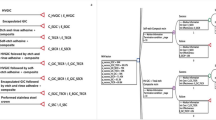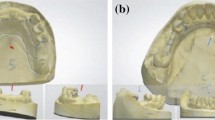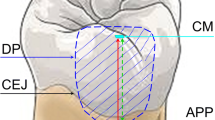Abstract
Single case reports indicate that components of dental alloys accumulate in the adjacent soft tissue of the oral cavity. However, data on a wider range of dental alloys and patient groups are scarce. Therefore, the aim of the present study was to examine the metal content of oral tissues adjacent to dental alloys showing persisting signs of inflammation or other discoloration (affected sites) and of healthy control sites with no adjacent metal restoration in 28 patients. The composition of the adjacent alloys was analyzed and compared to the alloy components in the affected sites. Tissue analysis was performed using atomic absorption spectroscopy. Alloy analysis was performed with energy-dispersive X-ray analysis. In the affected sites, the metals Ag, Au, Cu, and Pd prevailed compared to control sites, reflecting the frequency distribution of single metals in the adjacent alloys. In most cases (84%), at least one of the analyzed metals was a component of the alloy and also detected in the tissue. Metal components from almost all dental cast alloys can be detected in adjacent tissue.






Similar content being viewed by others
References
Bergenholtz A, Hedegård B, Söremark R (1965) Studies of the transport of metal ions from gold inlays into environmental tissues. Acta Odont Scand 23:135–146
Bundesärztekammer (Bundesverband der deutschen Zahnärztekammern) und Kassenzahnärztliche Bundesvereinigung (1995) Das Dental Vademekum. Deutscher Ärzte-Verlag, Köln München
Cherian M, Goyer R (1978) Metallothioneins and their role in the metabolism and toxicity of metals. Life Sci 23:1–9
Datenbank für Dentale Metallegierungen (1997) Von Praktikern für Praktiker; für (fast) alle Legierungen, die Zahnärzte in Deutschland einsetzen können. Edn 1.0. Spitta, Balingen
European Committee for Standardization (1995) EN ISO 1562: dental casting alloys. Brussels
European Committee for Standardization (1996) EN ISO 6871–1: dental base metal casting alloys. Part 1: cobalt-based alloys. Brussels
European Committee for Standardization (2000) EN ISO 8891: Dental casting alloys with noble metal content of at least 25% but less than 75%. Brussels
Garhammer P, Schmalz G, Hiller KA, Reitinger T (2001) Patients with local adverse effects from dental cast alloys: frequency, complaints, symptoms, allergy. Clin Oral Invest 5:240–249
Geurtsen W (2002) Biocompatibility of dental casting alloys. Crit Rev Oral Biol Med 13:71–84
Gray SJ, Stirling K (1950) Tagging of red cells and plasma proteins with radioactive chromium. J Clin Invest 29:1604–1613
Hensten-Pettersen A (1992) Casting alloys: side effects. Adv Dent Res 6:38–43
Kratzenstein B, Sauer KH, Weber H, Geis-Gerstofer J (1986) In-vivo-Korrosionsuntersuchungen goldhaltiger Legierungen. Dtsch Zahnärztl Z 41:1272–1276
Lau JC, Jackson-Boeters L, Daley TD, Wysocki GP, Cherian MG (2001) Metallothionein in human gingival amalgam tattoos. Arch Oral Biol 46:1015–1020
Marcusson JA (1996) Contact allergies to nickel sulfate, gold sodium thiosulfate and palladium chloride in patients claiming side effects from dental alloy components. Contact Dermatitis 34:320–323
Nau H (1997) Toxikokinetik. In: Marquard H, Schäfer SG (eds) Lehrbuch der Toxikologie. Spektrum, Heidelberg
Rechmann P (1992) LAMMS and ICP-MS detection of dental metallic compounds in not-discolored human gingiva. J Dent Res 71:599
Rechmann P (1993) Nachweis metallischer Restaurationsmaterialien in klinisch unauffälliger Gingiva. Dsch Zahnärztl Z 48:270–275
Rechmann P (1995) Aufnahme von Metallen in die Mundschleimhaut. Dtsch Z Mund Kiefer GesichtsChir 19:107–114
Reynolds JJ, Meikle MC (1997) Mechanisms of connective tissue matrix destruction in periodontitis. Periodontology 2000 14:144–157
Schäfer SG, Hannover B, Elsenhaus B, Forth W, Schümann K (1997) Metalle. In: Marquard H, Schäfer SG: Lehrbuch der Toxikologie. Spektrum, Heidelberg
Schmalz G, Garhammer P (2002) Biologic interactions of dental cast alloys with oral tissues. Dent Mat 18:396–406
Taylor DT, Morton TH Jr (1991) Ulcerative lesions of the palate associated with removable partial denture castings. J Prosthet Dent 66:213–221
Wataha JC (2000) Biocompatibility of dental casting alloys: A review. J Prosthet Dent 83:223–234
Wirz J, Schmidli F (1988) Korrosionsverhalten von Co-Basislegierungen für Kronen- und Brückenarbeiten. Quintessenz 11:1997–2008
Wirz J, Schmidli F, Jäger K (1992) Splittertest. Quintessenz 43:1017–1023
Acknowledgements
This study was supported by the German Ministry of Health. We thank Peter Geisenberger for EDX analysis of the cast alloys.
Author information
Authors and Affiliations
Corresponding author
Rights and permissions
About this article
Cite this article
Garhammer, P., Schmalz, G., Hiller, KA. et al. Metal content of biopsies adjacent to dental cast alloys. Clin Oral Invest 7, 92–97 (2003). https://doi.org/10.1007/s00784-003-0204-9
Received:
Accepted:
Published:
Issue Date:
DOI: https://doi.org/10.1007/s00784-003-0204-9




